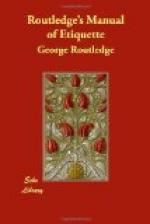This question of make or cut (call it which you please) is not sufficiently considered, especially by the young.
Some people think no one can be well dressed who is not expensively dressed, whose gown is not richly trimmed; but it is a great mistake. Many persons are absolutely ill-dressed who spend a fortune upon their clothes.
The young should bear in mind that simplicity is what harmonizes best with youth, but care must be taken to avoid the simplicity of the school-room and of a “miss in her teens.” We can call to mind a young lady who made her appearance at an evening party in London, where “all the world and his wife” were collected together, and when it was necessary to be somewhat smart, in a rather skimp spotted muslin, with a black belt and a few black cherries in her hair. She looked, as the reader will easily believe, like a young lady in her teens, who, as Byron said, “smells of bread and butter.” She was much on the wrong side of twenty. By her side stood a young girl who had not passed nineteen summers, dressed in the freshest costume of plain white tulle, with bright turquoise blue flowers in her hair, the very impersonation of youth and loveliness. The cost of the dress of these two young ladies was about the same, but the appearance of the two was by no means the same. The one was fresh and simple; the other simple but unfresh. The one attracted; the other repelled. At the same time we saw two sisters, one a blonde and the other dark, dressed unadvisedly alike in dark blue tarlatan, with an infinite number of beads round the body, peplum, and sleeves. It was in the height of summer, and the costume looked fusty and oppressive; while not far off stood a young girl in a white and green tarlatan dress prettily trimmed with old lace and green ribbon, with one large white flower in her hair—the very type of spring and early summer. None of these costumes were expensive, but they had widely different results.
We return to our former assertion that it is the make which renders a common material wearable in any,—even the very best society.
It requires, of course, a knowledge of the prevailing fashion, which may easily be arrived at by the simple process of taking in “Le Follet,” or some good monthly publication on fashions. It requires also a correct eye and a good taste to select such materials as shall harmonize well with the style which is in favour. It requires, above all, a good workwoman, who knows how to cut out, how to put in the gores, how to arrange the breadths, where to put the fulness; where to make the dress full, and where tight, how to avoid creases, how to cut the sleeves, and how to put them in, how to give the arm sufficient room so that the back shall not pucker, how to cut the body so that short waisted ladies shall not seem to have too short a waist, nor long-waisted ladies too long a one. This important question of a good lady’s-maid is one upon which depends the probability




